Electronic Structure Characterization of Hydrogen Terminated n-type Silicon Passivated by Benzoquinone-Methanol Solutions
Abstract
:1. Introduction
2. Materials and Methods
3. Results
3.1. SPV Measurements by XPS
3.2. SPV Measurements by SKPM
3.3. Surface Dipole and Work Function Calculation
4. Discussion and Conclusions
Acknowledgments
Author Contributions
Conflicts of Interest
References
- Bakke, J.R.; Pickrahn, K.L.; Brennan, T.P.; Bent, S.F. Nanoengineering and interfacial engineering of photovoltaics by atomic layer deposition. Nanoscale 2011, 3, 3482–3508. [Google Scholar] [CrossRef] [PubMed]
- Takato, H.; Sakata, I.; Shimokawa, R. Surface passivation of silicon substrates using quinhydrone/methanol treatment. In Proceedings of the 3rd World Conference on Photovoltaic Energy Conversion, Osaka, Japan, 11–18 May 2003; Volume 2, pp. 1108–1111. [Google Scholar]
- Takato, H.; Sakata, I.; Shimokawa, R. Quinhydrone/methanol treatment for the measurement of carrier lifetime in silicon substrates. Jpn. J. Appl. Phys. 2002, 41, L870–L872. [Google Scholar] [CrossRef]
- Watanabe, N.; Kondo, Y.; Ide, D.; Matsuki, T.; Takato, H.; Sakata, I. Characterization of polycrystalline silicon wafers for solar cells sliced with novel fixed-abrasive wire. Prog. Photovolt. Res. Appl. 2010, 18, 485–490. [Google Scholar] [CrossRef]
- Har-lavan, R.; Schreiber, R.; Yaffe, O.; Cahen, D. Molecular field effect passivation: quinhydrone/methanol treatment of n-Si(100). J. Appl. Phys. 2013, 113, 084909. [Google Scholar] [CrossRef]
- Chen, M.; Hack, J.H.; Iyer, A.; Jones, K.J.; Opila, R.L. Radical-driven silicon surface passivation by benzoquinone-, hydroquinone-methanol and photoinitiators. J. Phys. Chem. C 2017, 121, 21364–21373. [Google Scholar] [CrossRef]
- Kotulak, N.A.; Chen, M.; Schreiber, N.; Jones, K.; Opila, R.L. Examining the free radical bonding mechanism of benzoquinone- and hydroquinone-methanol passivation of silicon surfaces. Appl. Surf. Sci. 2015, 354, 469–474. [Google Scholar] [CrossRef]
- He, T.; Ding, H.; Peor, N.; Lu, M.; Corley, D.A.; Chen, B.; Ofir, Y.; Gao, Y.; Yitzchaik, S.; Tour, J.M. Silicon/molecule interfacial electronic modifications. J. Am. Chem. Soc. 2008, 130, 1699–1710. [Google Scholar] [CrossRef] [PubMed]
- Gleason-Rohrer, D.C.; Brunschwig, B.S.; Lewis, N.S. measurement of the band bending and surface dipole at chemically functionalized Si(111)/vacuum interfaces. J. Phys. Chem. C 2013, 117, 18031–18042. [Google Scholar] [CrossRef]
- Schottky, W. On semiconductors theory of the interphase and peak rectifiers. J. Phys. A Hadron. Nucl. 1939, 113, 367–414. [Google Scholar] [CrossRef]
- Mott, N.F. Note on the contact between a metal and an insulator or semi-conductor. Math. Proc. Camb. Philos. Soc. 1938, 34, 568–572. [Google Scholar] [CrossRef]
- Zhen, H.; Yates, J.T.J. Band bending in semiconductors: Chemical and physical consequences at surfaces and interfaces. Chem. Rev. 2012, 112, 5520–5551. [Google Scholar] [CrossRef]
- Kronik, L.; Shapira, Y. Surface photovoltage phenomena: Theory, experiment, and applications. Surf. Sci. Rep. 1999, 37, 1–206. [Google Scholar] [CrossRef]
- Jing, L.; Sun, X.; Shang, J.; Cai, W.; Xu, Z.; Du, Y.; Fu, H. Review of surface photovoltage spectra of nano-sized semiconductor and its applications in heterogeneous photocatalysis. Sol. Energy Mater. Sol. Cells 2003, 79, 133–151. [Google Scholar] [CrossRef]
- Sell, K.; Barke, I.; Polei, S.; Schumann, C.; von Oeynhausen, V.; Meiwes-Broer, K.H. Surface photovoltage of Ag nanoparticles and Au chains on Si(111). Phys. Status Solidi 2010, 247, 1087–1094. [Google Scholar] [CrossRef]
- Magid, I.; Burstein, L.; Seitz, O.; Segev, L.; Kronik, L.; Rosenwaks, Y. Electronic characterization of Si(100)-bound alkyl monolayers using kelvin probe force microscopy. J. Phys. Chem. C 2008, 112, 7145–7150. [Google Scholar] [CrossRef]
- Kresse, G.; Furthmüller, J. Efficient Iterative schemes for ab initio total-energy calculations using a plane-wave basis set. Phys. Rev. B 1996, 54, 11169. [Google Scholar] [CrossRef]
- Blöchl, P.E.; Jepsen, O.; Andersen, O.K. Improved tetrahedron method for brillouin-zone integrations. Phys. Rev. B 1994, 49, 16223. [Google Scholar] [CrossRef]
- Perdew, J.P.; Burke, K.; Ernzerhof, M. Generalized gradient approximation made simple. Phys. Rev. Lett. 1996, 77, 3865–3868. [Google Scholar] [CrossRef] [PubMed]
- Northrup, J.E. Structure of Si(100)H: Dependence on the H chemical potential. Phys. Rev. B 1991, 44, 1419–1422. [Google Scholar] [CrossRef]
- Natan, A.; Kronik, L.; Shapira, Y. Computing surface dipoles and potentials of self-assembled monolayers from first principles. Appl. Surf. Sci. 2006, 252, 7608–7613. [Google Scholar] [CrossRef]
- Cahen, D.; Kahn, A. Electron energetics at surfaces and interfaces: Concepts and experiments. Adv. Mater. 2003, 15, 271–277. [Google Scholar] [CrossRef]
- Sze, S.M.; Ng, K.K. Metal-Semiconductor Contacts. In Physics of Semiconductor Devices, 3rd ed; John Wiley & Sons, Inc.: New York, NY, USA, 1981; pp. 134–196. [Google Scholar]
- Hunger, R.; Fritsche, R.; Jaeckel, B.; Jaegermann, W.; Webb, L.J.; Lewis, N.S. Chemical and electronic characterization of methyl-terminated Si(111) surfaces by high-resolution synchrotron photoelectron spectroscopy. Phys. Rev. B 2005, 72, 45317. [Google Scholar] [CrossRef]
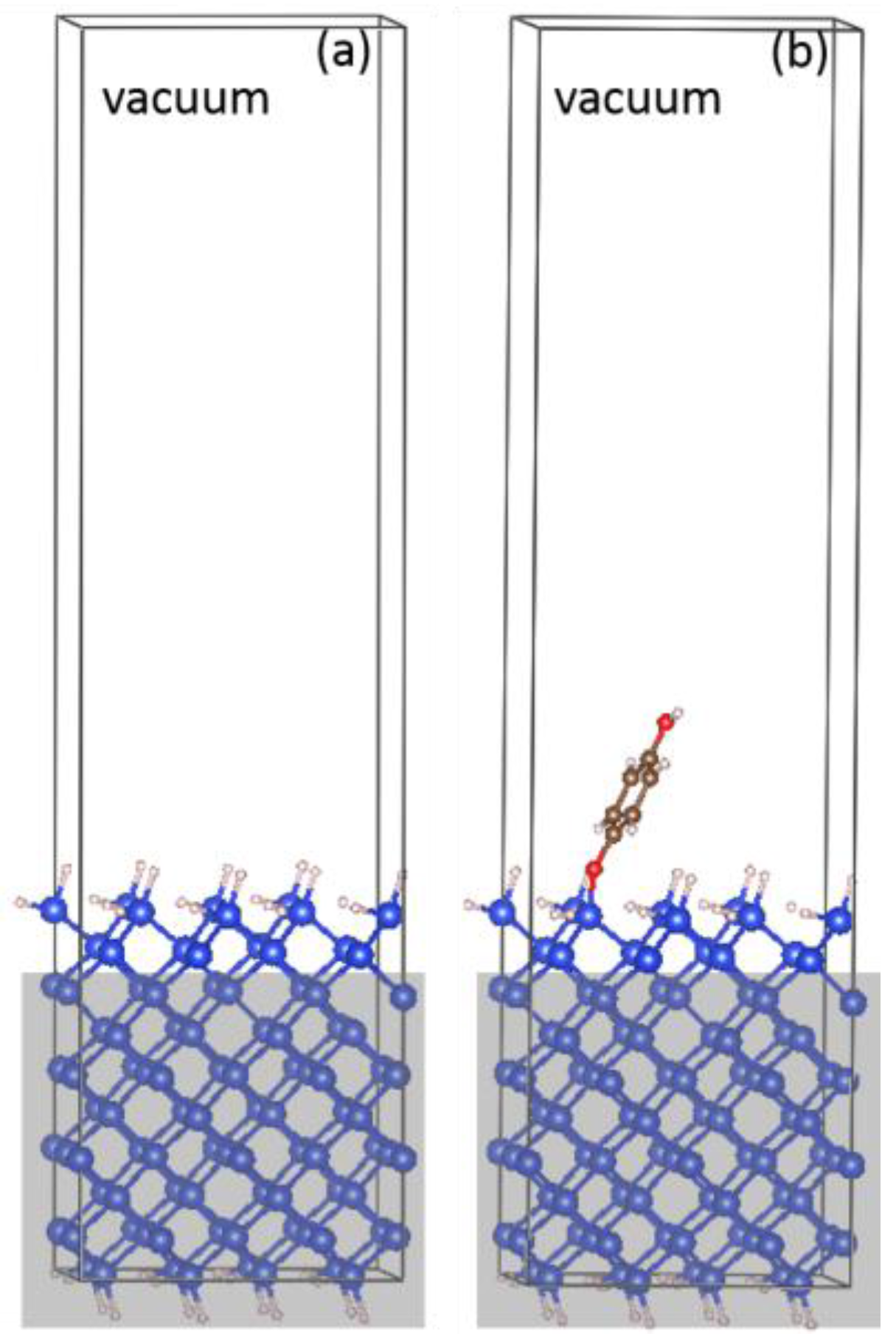



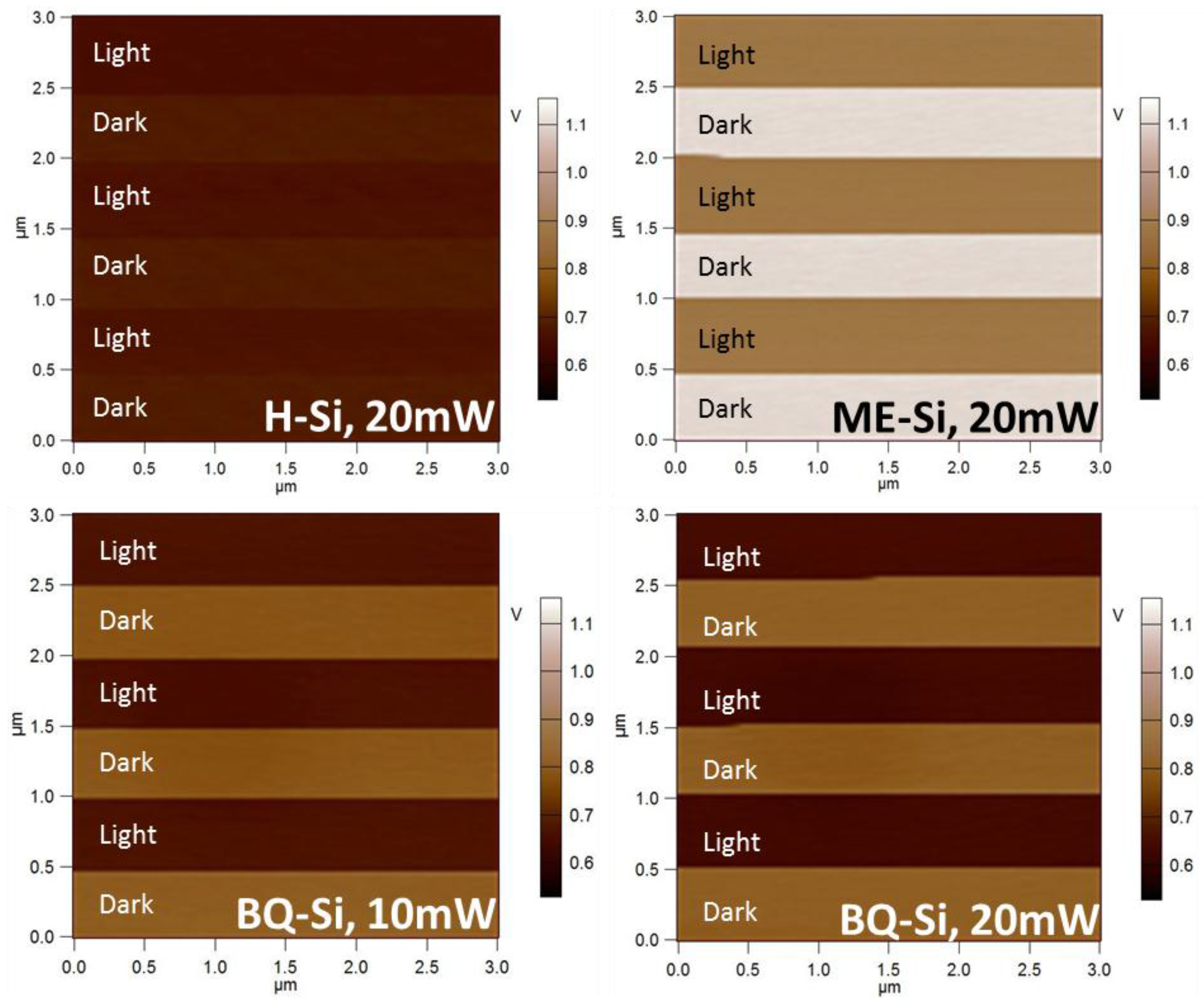
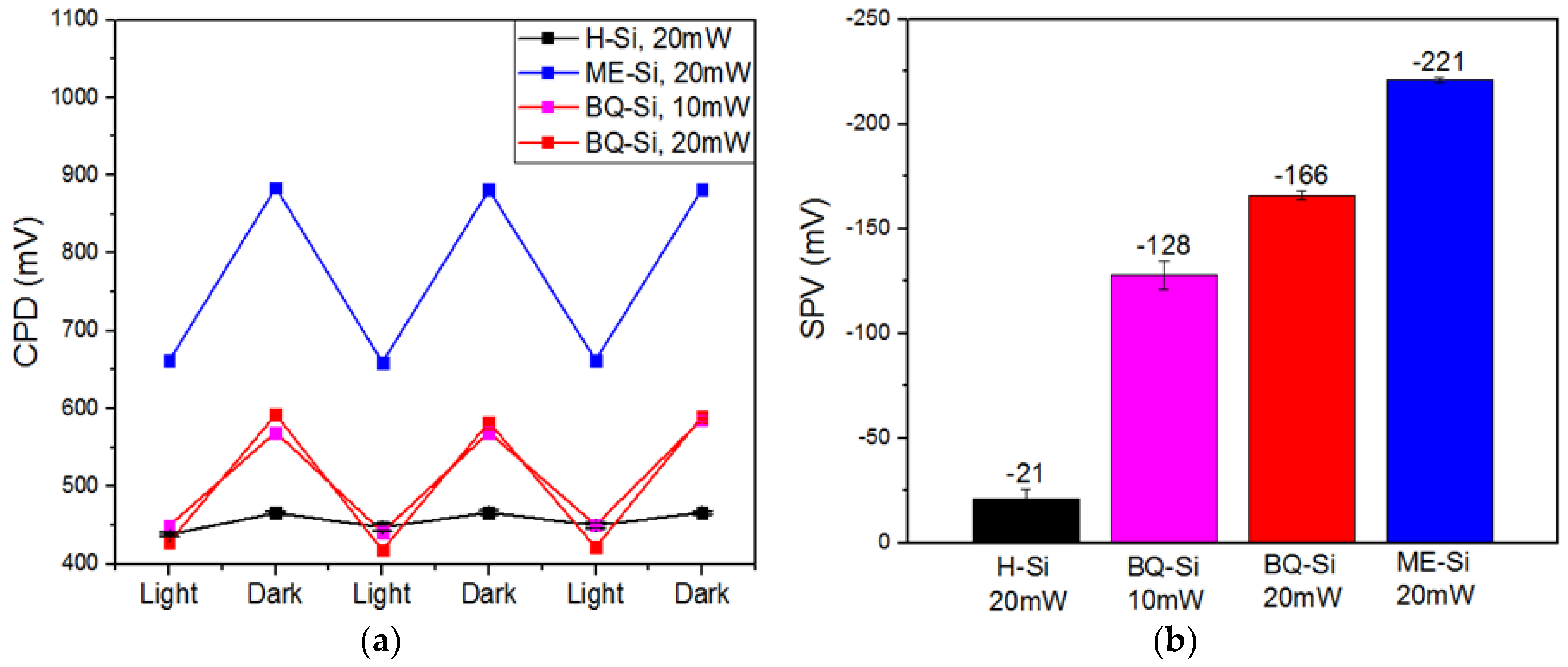

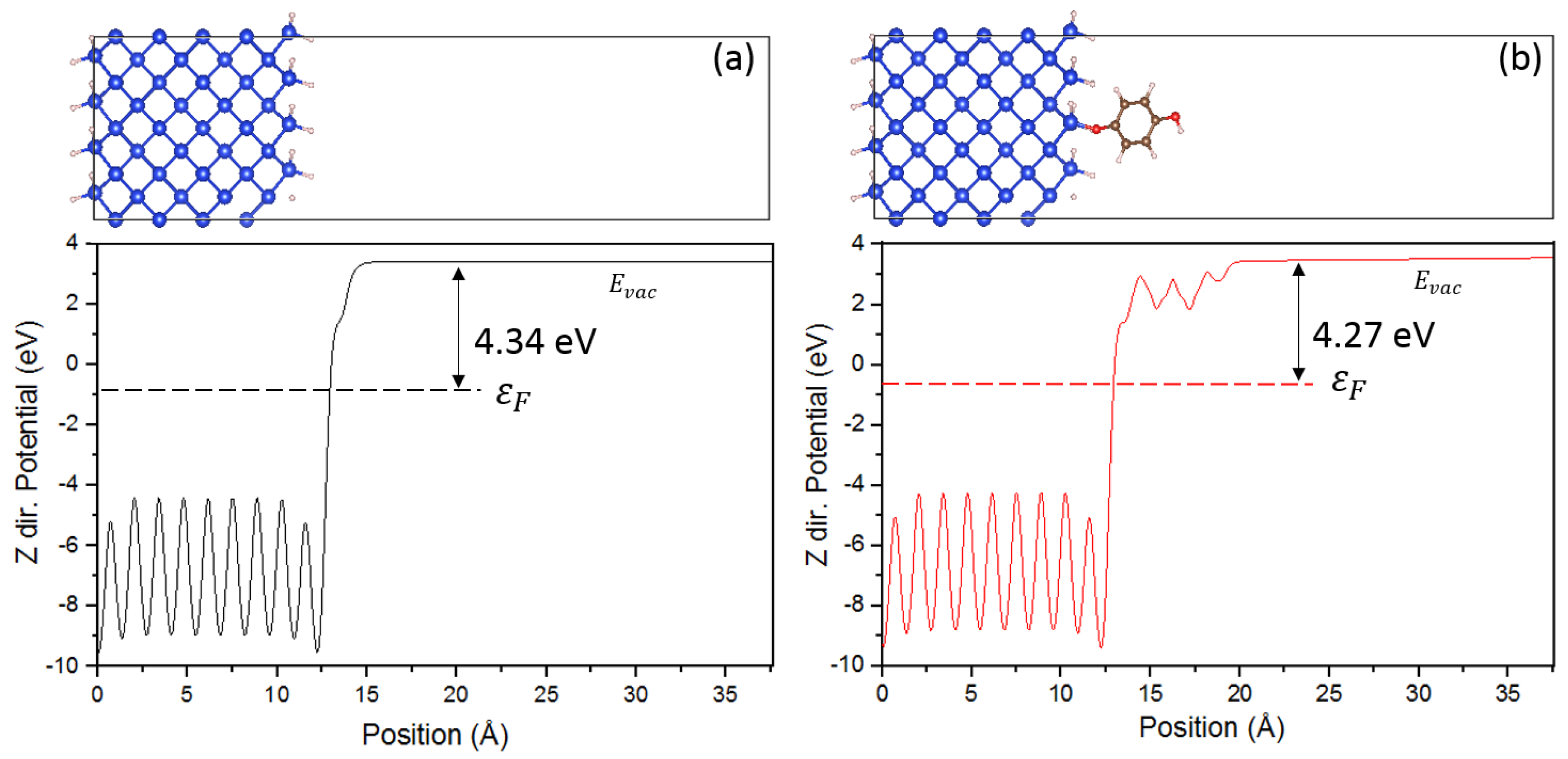
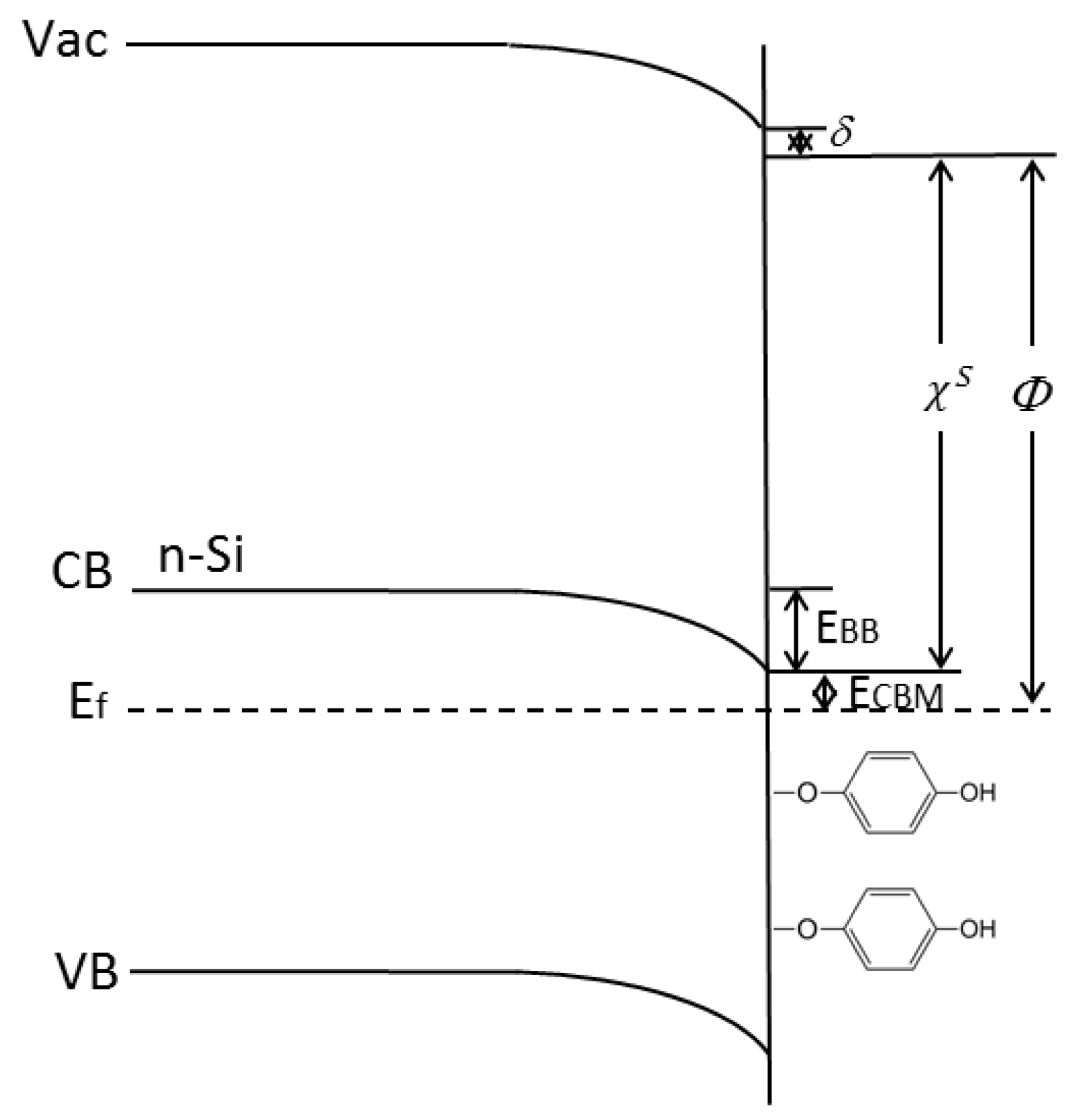
© 2018 by the authors. Licensee MDPI, Basel, Switzerland. This article is an open access article distributed under the terms and conditions of the Creative Commons Attribution (CC BY) license (http://creativecommons.org/licenses/by/4.0/).
Share and Cite
Chen, M.; Hack, J.H.; Lin, X.; Janotti, A.; Opila, R.L. Electronic Structure Characterization of Hydrogen Terminated n-type Silicon Passivated by Benzoquinone-Methanol Solutions. Coatings 2018, 8, 108. https://doi.org/10.3390/coatings8030108
Chen M, Hack JH, Lin X, Janotti A, Opila RL. Electronic Structure Characterization of Hydrogen Terminated n-type Silicon Passivated by Benzoquinone-Methanol Solutions. Coatings. 2018; 8(3):108. https://doi.org/10.3390/coatings8030108
Chicago/Turabian StyleChen, Meixi, James H. Hack, Xi Lin, Anderson Janotti, and Robert L. Opila. 2018. "Electronic Structure Characterization of Hydrogen Terminated n-type Silicon Passivated by Benzoquinone-Methanol Solutions" Coatings 8, no. 3: 108. https://doi.org/10.3390/coatings8030108




